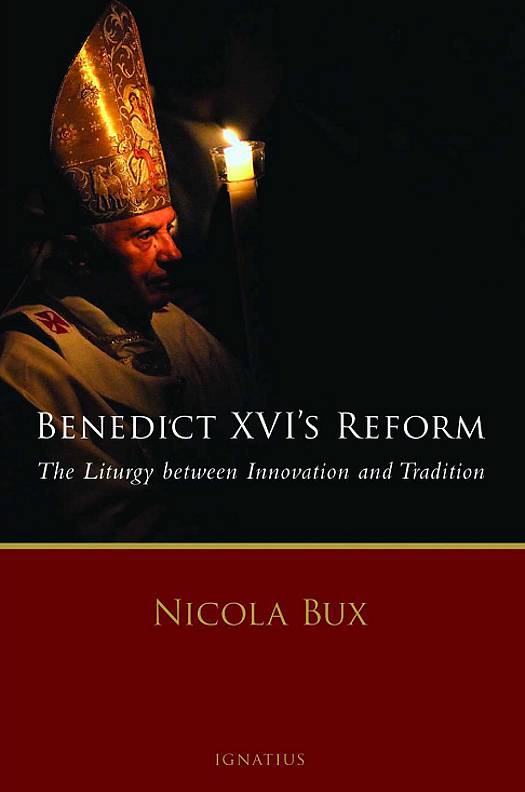Jeg nevte tidligere i dag intervjuet med msgr. Nicola Bux om hans nye bok om liturgien. I dette intervjuet sier han også:
«När Benedikt XVI talade om brytning eller ”påhittad liturgi” menade han att denna ”förbindelse” har avbrutits. Mässans betydelse av offergärning har ersatts av en minneshögtid som kommerorerar Skärtorsdagens sista måltid. Det är i detta som den främsta brytningen ligger. Självaste Paulus VI rättade denna heresi i den första editio typica (officiella utgåvan, ö.a.) av det romerska missalet (artikel 7). Mässan är naturligtvis även en måltid, men det rör sig om påskmåltiden, om Guds lamm som offras för oss. Den gudomliga liturgin, som man säger i Östkyrkan, är en ”mystisk måltid” med den offrade kroppen och blodet som gjutits in remissionem peccatorum (för våra synders skull). Även Uppenbarelseboken beskriver den eviga liturgin som på denna jord utförs i kyrkans liturgi. Den broderliga aspekten, eller snarare gemenskapsaspekten, i mässan härrör enbart ur detta mysterium.»
I gårsdagens høymesse i St Hallvard kirke prøvde jeg å vise svært så tydelig at messen er et offer, gjennom en kort innledning i starten av messen, ved å bruke første eukaristiske bønne (og ved hjelp av en dyktig organist og gode ministranter) og gjennom min preken, der jeg delvis bygget på det jeg sa på denne søndagen for tre år siden – se her.
I prekenen sa jeg bl.a.: » … … denne søndagen vil jeg også til å ta opp i min preken temaet om offer og Kristi prestetjeneste fra 2. lesning. I dag hørte vi fra Hebreerbrevet 5: En øversteprest blir alltid tatt blant mennesker og innsatt for å gjøre tjeneste for Gud på vegne av mennesker. Han skal bære fram gaver og offer for synder. … heller ikke Kristus har tiltatt seg den ære å være øversteprest. Han fikk den av Gud som sa til ham: Du er min sønn, jeg har født deg i dag. Likeså sier han på et annet sted: Du skal være prest til evig tid på Melkisedeks vis.»
Melkisedek levde på Abrahams tid, Abraham gav tiende av alt han hadde til denne mannen, som allerede før Abraham, tjente og ofret til den høyeste Gud. Melkisedek er kanskje det viktigste forbildet på Kristus, på en prest som bærer frem offer som Gud gjerne tar imot, og Melkisedek nevnes hver gang vi bruker den første eukaristiske bønn.
I messens andre lesning hører vi nå uke etter uke fra Hebreerbrevet. I dag begynner temaet i Hebreerbrevet om Kristi prestetjeneste og dette fortsetter flere uker fremover. Neste søndag hadde vi hørt – hvis det ikke hadde feiret Allehelgensdag – fra Hebr 7,23-27: «Men Jesus har et prestedømme som ikke tar slutt, fordi han er og blir til evig tid. Derfor kan han også fullt og helt frelse dem som kommer til Gud ved ham, fordi han alltid lever og går i forbønn for dem. Ja, en slik øversteprest var det vi måtte ha: hellig, god og ren, skilt ut fra syndere og opphøyd over himlene. Offeret har han båret fram én gang for alle da han ofret seg selv.»
Dernest på 32. søndag fra Hebr 9,24-28: «For Kristus gikk ikke inn i en helligdom som er gjort av menneskehånd og bare er et bilde av den sanne helligdom. Han gikk inn i selve himmelen; nå skulle han for vår skyld tre fram for Guds ansikt. Han … åpenbarte seg én gang for alle ved tidenes ende for å utslette synden ved sitt offer.»
Den siste lesningen fra hebreerbrevet kommer 33. søndag, og er fra Hebr 10.11-14 og v18: «Alle andre prester står daglig og gjør tjeneste og bærer gang på gang fram de samme offer, som likevel aldri kan ta bort synder. Men Jesus har båret fram et eneste offer for synder og har deretter satt seg ved Guds høyre hånd for alltid.»
Dette offeret som Jesus har båret fram for Gud Fader da han døde på korset, er det som blir gjort nærværende og båret fram for Herre, i hver eneste messe som feires. Derfor er messen så viktig; vi får del i Kristi offer på en helt spesiell måte.»


